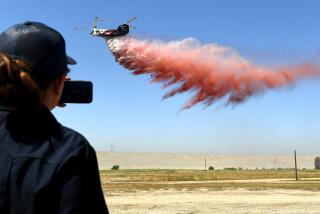Help From Above : Blimp Could Be Counted on to Play a Role During an Emergency
- Share via
If there’s a major earthquake in Los Angeles and you’re cut off from the outside world, you may be able to get emergency information from a 192-foot-long, 202,000-cubic-foot bag of helium--the famous Goodyear Blimp.
For the past several years, officials of the Goodyear Tire & Rubber Co., owners of the Carson-based Goodyear blimp Eagle, have been working with disaster response officials on plans to make use of the blimp during catastrophes of one sort or another.
This week, those preparations progressed with the creation of a backup mooring site for the blimp in a dusty field on the campus of Cal State Dominguez Hills, about a mile from the blimp’s permanent concrete-and-asphalt landing pad in Carson.
The blimp touched down at the emergency landing site Thursday and then took several local emergency-management officials on a mock “damage assessment” flight.
“There is a lot of potential usefulness for an airship in the event of a disaster,” said Bob Urhausen, public relations director for the Eagle, one of three Goodyear blimps. The other two are the Stars and Stripes, based in Florida, and the Spirit of Akron, based in Ohio.
*
Ironically, although the Eagle’s mock disaster flight took place after the worst disaster to hit Southern California in years--the recent wildfires--Urhausen noted that the blimp’s usefulness during fires is limited.
For one thing, the blimp can’t fly in winds stronger than 20 to 25 m.p.h.; also, the tremendous heat from a fire would cause the helium-filled blimp to ascend too rapidly. This week’s practice emergency flight had been planned before the fires erupted.
However, after an earthquake or a flood, the blimp could provide yeoman service, Urhausen said. In fact, he said, a blimp’s disaster capabilities already have been demonstrated.
After Hurricane Andrew hit Florida last year, Florida Gov. Lawton Chiles called on the Stars and Stripes for assistance. The airship flew over isolated damage areas and used its lighted message signs to display emergency assistance information and warn residents against drinking contaminated tap water.
“If there were an earthquake here, we could take off and fly around to a lot of different areas,” Urhausen said. “The primary application probably would be our night sign capabilities. We could get information to people who might not be able to get it any other way.”
The lighted message signs on both sides of the blimp, which usually carry advertising and public service messages, are more than 100 feet long and 24 feet high, and can be read by people on the ground from a mile away during periods of normal visibility.
*
The Eagle already has had some experience with disasters. In 1989 the blimp, then called the Columbia, was filming a World Series game in San Francisco when the Bay Area earthquake struck.
“We went from a sportscast to a newscast in about 30 seconds,” Urhausen said. He added that the Eagle helped provide valuable coverage of that disaster.
Urhausen said the Eagle’s low speed--it cruises at 35 m.p.h.--and its ability to stay airborne for up to 20 hours make it an ideal vehicle for that kind of operation. Also, unlike a helicopter, the blimp’s stability and lack of mechanical vibration make it a perfect platform for aerial photography, which is one reason it’s often used for overhead shots of football games.
Urhausen said that if the Eagle is called into service in an emergency there would be no charge to disaster relief agencies, even though it costs about $900 an hour to operate the blimp.
“I think (the Eagle) has wonderful potential in an emergency,” said Eileen Edgerton, safety and emergency services supervisor for the city of Carson, and one of the officials who took the practice emergency flight.
The backup landing site at Cal State Dominguez Hills would allow the Eagle to operate even if its permanent landing pad at the Goodyear Airship Operations facility on Main Street in Carson were damaged.
*
The blimp spends about six months of the year traveling to sporting events and other destinations. When in Carson, it usually makes about 10 flights a day, carrying Goodyear corporate clients and sales personnel on 45-minute rides across the South Bay area. (Rides on the six-passenger blimp are not available to the public.)
Blimp crew members are proud of their safety record.
“Never lost a passenger yet, and I don’t intend to,” said the Eagle’s chief pilot, Nick Nicolary, 52, who’s been flying Goodyear blimps for the past 26 years. He is one of five pilots and 16 crew members assigned to the Eagle.
There have been problems, however. In 1990, a remote-controlled model plane collided with the blimp, leaving a gash of one square foot in the blimp’s rubber-coated polyester skin. And in 1981, a Goodyear blimp was destroyed on the ground by a freak storm that hit Carson.
More to Read
Sign up for Essential California
The most important California stories and recommendations in your inbox every morning.
You may occasionally receive promotional content from the Los Angeles Times.










